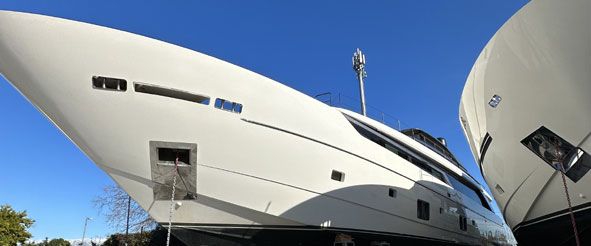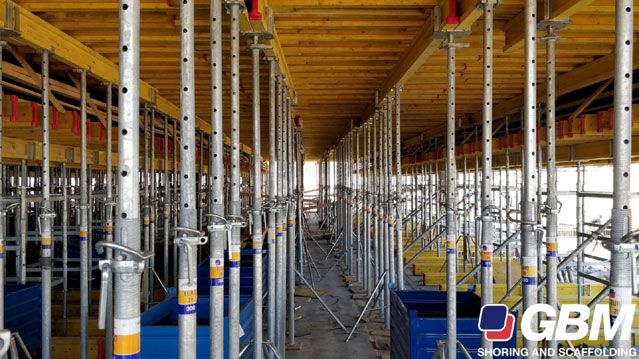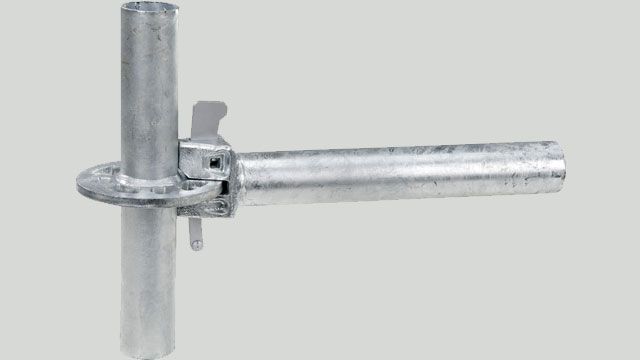Galvanized shoring props:
"All that glitters is not zinc."
Galvanized props: the shiniest, the better? Not always.
Judging the quality of building material based on the aesthetic appearance is not always the best criterion.
Knowing products and applications in-depth is always a better option: here are a few tips on appropriate assessment of props.
In construction sites, you will easily find props as shiny as mirrors and opaque props alike. However, it is not a matter of new or old props: it depends on the galvanisation process which determines the different brightness of the pipe. A difference beyond the aesthetic appearance. This is why a shinier and “more beautiful” prop is not necessarily the best for a given worksite.
As a process, galvanisation is crucial towards protecting steel and iron products against corrosion arising from weather and atmospheric agents. However, other elements - not always perceivable to the eyes - must be taken into account for proper assessment of the outcome of a galvanisation process. Which?
Iron and steel: let us be clear
Let us take a step back to understand the end result: source materials.
The terms “iron” and “steel” are actually commonly misused, at times opposing each other and almost as synonyms other times.
Iron is one of the most common chemical elements in the universe and it counts for almost a sixth of the total mass of planet earth; in high concentrations in the inner layers in the earth's core and mantle, it is also the element most commonly found on the earth’s crust, counting for slightly less than 5% of the composition thereof.
As a metal, iron is extracted from its minerals, chemical compounds which must be chemically reduced (actually, finished products do not usually refer to something entirely made of iron).
Once through with this operation, iron is combined with other elements, to obtain various alloys including steel.
Steel: this is the name given to an alloy made up of iron and carbon, the latter at a percentage not exceeding 1.7% of the total (considered among cast iron products if exceeding).
The characteristic classification of steel is the percentage of carbon, which ranges from extra mild steel (low carbon content) to extra hard steel (high carbon content). Depending on the type and use of steel, there may be countless alloy elements, though at amounts most appropriate to be measures in parts per million, regarding which a good summary can be found here: https://en.wikipedia.org/wiki/Steel
Through with the basic concepts, here is where galvanisation comes into play.
Galvanisation: what is it and what is it for
Hot-dip galvanisation is the process through which a zinc coating is applied onto a metal object (steel in this case) to protect it against corrosion. This results in a coating that protects the wholeness of the object uniformly, coating both the inner and outer surfaces. A result that is difficult to obtain through other methods.
Thus, galvanising works on several fronts:
1. Resistance to abrasion
As compared to application of other types of protection layers that usually provide for the use of polymeric films, zinc is a metal and it offers greater resistance against impacts and abrasions (breaking the zinc barrier requires considerable mechanical or acid action).
2. Resistance to corrosion
Galvanisation protects the underlying metal in three different ways:
Barrier effect
The coating insulates the underlying metal from the external environment and its corrosive agents;
Cathodic (sacrificial) effect
Zinc is an anode part and it preserves steel by absorbing corrosion: the underlying metal will be fully protected as long as there is zinc on the surface;
Sealing effect
Corrosion of zinc generates insoluble products which form a homogeneous surface once deposited on the material, thus protecting the material against the corrosion process.
How long is galvanisation effective?
Galvanising a prop entails several actual benefits that continue over time making the preservation process more appropriate in the long term.
The effectiveness of the treatment depends:
on the thickness of the coating
on the metallurgic features of the coated product
on the zinc corrosion speed or the different atmospheric conditions, it is exposed to (regulated by the ISO 9223 and ISO 14713-1 standards).
|
Corrosion Category |
Exemplifying environment |
Average loss of zinc layer per year (microns) |
|
C1 |
Indoor - Dry |
X <= 0,1 |
|
C2 |
Indoor- Occasional condensations |
0,1 |
|
C3 |
Indoor - High humidity Outdoor – Non-marine urban |
0,7 |
|
C4 |
Indoor– Swimming pools, chemical plants and the like Outdoor – Marine urban and non-marine industrial |
2,1 |
|
C5 |
Outdoor – Marine industrial or very humid/salty |
4,2 |
Starting from this data, and calculating the standard galvanising thicknesses without use under extreme conditions, a properly done galvanisation offers protection ranging between 40 years to slightly more than one century.
What determines the appearance of a galvanised prop?
There are various factors that can contribute towards different visual effects, starting from the same products treated differently, or starting from two different products treated in the same way.
Metal thickness: for objects to be galvanised with large thicknesses, or products that require portions with different thicknesses, obtaining partly shiny and partly opaque surfaces is only physiological. The fine thicknesses instead tend to have a shinier appearance;
Metal chemical composition: the presence of some elements (even in amounts that are so small as to be measured in parts per million) in the steel alloy may make the galvanisation opaque;
Metal rolling: various types of results may be obtained depending on the type of metal rolling when manufacturing the product to be galvanised. The hot-rolled product tends to obtain an already opaque and more knurled surface, while a cold-rolled product tends to obtain a smoother and shinier surface.
In conclusion: do building materials galvanising technical requirements lay down any aesthetic standards?
Short answer: no.
Galvanisation regulated by the EN ISO 1461 standard lays down requirements and features but none of them outlines aesthetic verification parameters.
Detailed answer: besides the opaqueness or shininess of a galvanised product not being measurable, it is a parameter of minor importance in terms of quality and efficiency even if it existed.
Considering a galvanised extremely smooth to the touch and very shiny product, were the visual aspect to push you to opt for a rougher and opaquer product, what matters most to you is to understand what lies behind this aesthetic result. Thus, there is no direct link between the appearance and the actual quality.
When examining a galvanised prop or when comparing two props with very different visual appearance, what matters is that the product in question be capable of revealing how and when galvanisation was carried out.
It is not easy to understand much more useful objective data based on the aesthetic appearance: a very smooth and shiny aspect could at times imply a lower galvanisation thickness in a
Make the choice that best suits you
At this point, the most important assessment does not lie in the product: it lies in the expertise of the manufacturer and the certificates that can be exhibited by the latter.
Keep off anyone insisting on a greater aesthetic appeal alone.
After going through this excursus on galvanisation and its importance, identify the exact type of product you need and the relative form of protection.
If in need of quality galvanised props that are durable over time and strictly compliant with the European standards, please take a look at our catalogues and feel free to contact us directly!
Contact us
- By email: sales@gbmitaly.com
- By phone tel: +39 030 9067005
- By filling out the form below!
Ultimo aggiornamento:
News

GBM's shipbuilding scaffoldings

Props required to sustain a slab: guidelines on how to establish distances, classes and quantities.

Multidirectional scaffolding GBM certified EN 17067:2013
Kontakte: info, çmime dhe preventiv.
Dëshiron më shumë information mbi produktet GBM? Na pyet për gjithçka!
 Italiano
Italiano English
English Deutsch
Deutsch Français
Français Português
Português Polski
Polski Български
Български Română
Română Español
Español Русский
Русский Српски
Српски Hrvatski
Hrvatski Slovenski
Slovenski Shqip
Shqip Magyar
Magyar English (US)
English (US)